21.05.2022
Boeing Starliner docks with ISS marking NASAs first simultaneous use of two crew vehicles
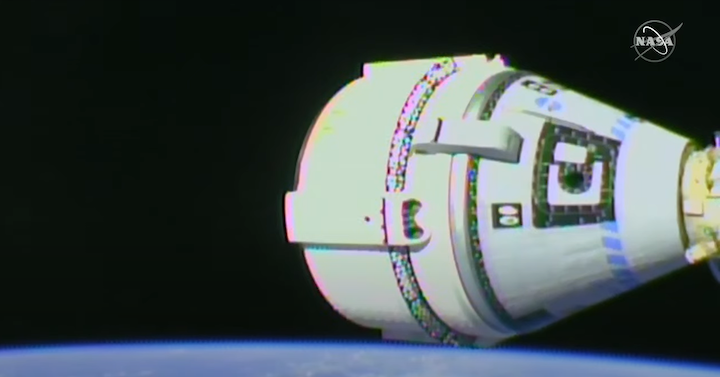
The uncrewed Boeing Starliner capsule successfully docked with the International Space Station for the first time Friday evening, a long-awaited milestone for a capsule that had fallen far behind its SpaceX Crew Dragon counterpart.
The docking occurred nearly 26 hours after Starliner's liftoff aboard an Atlas V rocket from Launch Complex 41 at Cape Canaveral Space Force Station.
Boeing and NASA teams on the ground in Houston worked in conjunction with NASA astronauts aboard the ISS to send commands to the capsule and eventually guide it in for docking at 8:28 p.m.
For the first time, both astronaut capsules of NASA's Commercial Crew Program -- Boeing's Starliner and SpaceX's Crew Dragon -- are simultaneously docked with the space station.
The Orbital Flight Test 2 mission is an uncrewed demonstration flight that has been delayed for years as a part of NASA's Commercial Crew Program, the $8 billion venture to develop the Starliner and Crew Dragon.
NASA invested in two companies to develop astronaut capsules to ensure a system of redundancy for crew transportation in an effort to move away from solely relying on Russia to transport its astronauts on Soyuz capsules at $90 million a seat.
SpaceX's Crew Dragon has been in constant operation transporting a total of 18 astronauts to and from the ISS since its first crewed demonstration flight in May 2020. The Starliner, in contrast, experienced a series of setbacks including an aborted mission in 2019, adding years of delays and costing the company over half a billion dollars to rectify.
Friday's rendezvous and docking process took about five hours to complete once the capsule caught up with the space station after chasing it for nearly 21 hours.
Upon Starliner's docking, NASA astronaut Bob Hines offered words of congratulations to the joint Boeing and NASA teams, "The crew of Expedition 67 would like to offer our congratulations on this momentous occasion. Today marks a great milestone, providing additional commercial access to low Earth orbit, sustaining the ISS, and enabling NASA's goal of returning humans to the moon and eventually to Mars."
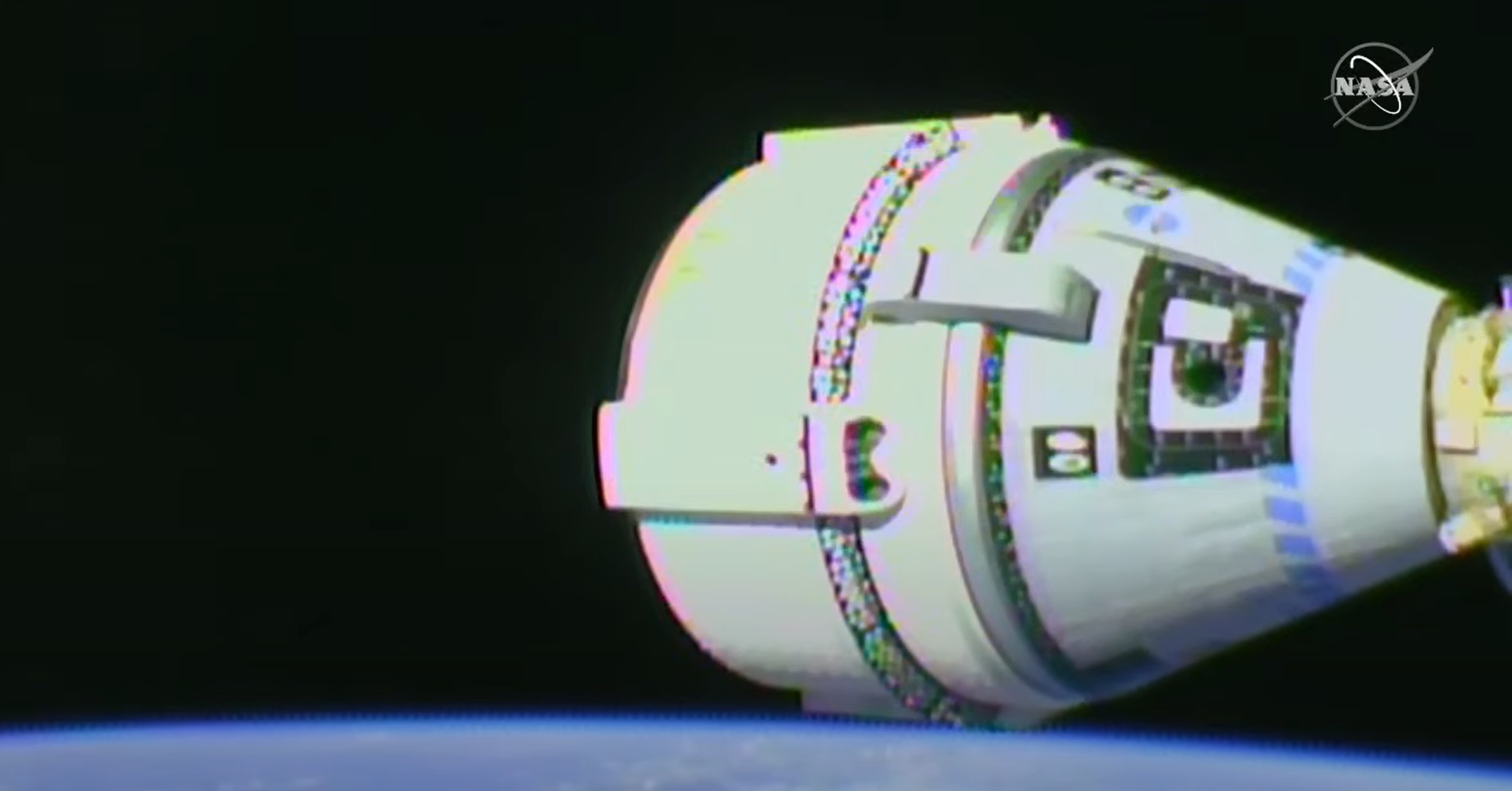
Shortly after Satarliner separated from its ULA Atlas V booster on Thursday, two of the 12 thrusters on the backside of the capsule failed to work perfectly. A third thruster was able to pick up the slack and perform correctly for the remainder of the maneuver.
A cooling system on board the capsule also performed slightly out of expectation on the way to the ISS. The issues with the capsule, however, did not impact its capability to proceed with the mission.
Furthermore, an issue with the NASA docking system on Starliner caused an additional thirty-minute delay Friday. Starliner controllers on the ground in Houston had to retract the docking mechanism to reset it before a docking attempt with the space station.
Starliner will remain attached to the space station for the next five days before returning for a parachute-assisted landing in New Mexico at the Army's White Sands Missile Range.
On Saturday, NASA astronauts Kjell Lindgren and Bob Hines of NASA's SpaceX Crew-4 mission who assisted Boeing and NASA teams with the Starliner's approach and docking will open the hatches between the space station and the capsule to unload about 800 pounds of cargo.
Even with the successful docking under its belt, Boeing still has many issues to work out with Starliner before astronauts will fly on it.
The final hurdle that Starliner needs to clear before NASA certifies it as a human-rated spacecraft will come as the Crewed Flight Test. That mission is set to occur sometime before mid-2023 and will carry two or three NASA astronauts to the space station and back.
Once the OFT-2 Starliner lands in New Mexico sometime next week it will be transported back to Boeing's factory at Kennedy Space Center in Florida.
The company will spend the next several months processing the capsule and developing long-term solutions to the issues that were encountered during the OFT-2 mission to prepare for the highly-anticipated first crewed mission. Quelle: Florida Today +++
Starliner docks with ISS for the first time 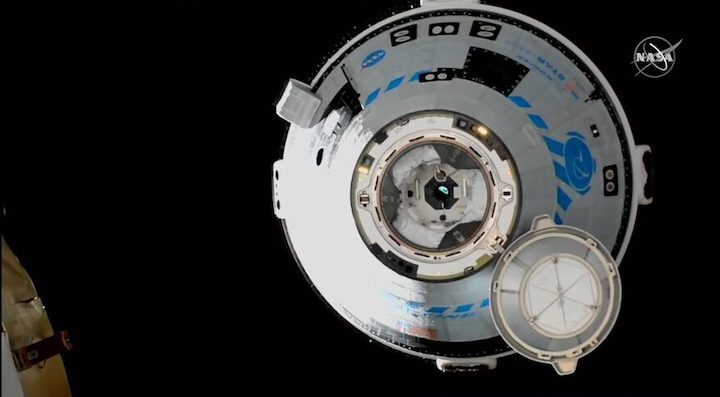 Boeing's CST-100 Starliner approaching the International Space Station shortly before its docking. Credit: NASA TV
Boeing's CST-100 Starliner approaching the International Space Station shortly before its docking. Credit: NASA TV
Updated 10:45 p.m. Eastern with post-launch briefing comments.
TITUSVILLE, Fla. — Boeing’s CST-100 Starliner spacecraft successfully docked with the International Space Station May 20, a little more than 24 hours after its launch.
The spacecraft docked with the forward docking port on the Harmony module of the station at 8:28 p.m. Eastern. Controllers reported a hard docking securing the spacecraft to the station about 20 minutes later, although hatches separating the spacecraft from the station won’t open until around 11:45 a.m. Eastern May 21.
The docking took place more than an hour later than the original schedule as controllers worked through several minor issues. That included the spacecraft’s docking ring, which needed to be retracted and extended again before the spacecraft could make its final approach.
“To the joint Boeing and NASA team, the crew of Expedition 67 would like to offer our congratulations on this momentous occasion,” NASA astronaut Bob Hines, currently on the station, said after the docking was confirmed. “Today marks a great milestone towards providing additional commercial access to low Earth orbit, sustaining the ISS and enabling NASA’s goal of returning humans to the moon and eventually to Mars.”
“This was a really critical demonstration mission,” Kathy Lueders, NASA associate administrator for space operations, said in a briefing an hour after docking. “Seeing that vehicle docked now to the ISS is just phenomenal.”
Neither NASA nor Boeing provided updates about the status of the Orbital Flight Test (OFT) 2 mission for more than 17 hours after a postlaunch briefing May 19, an unusual silence that raised concerns that there was a problem with the spacecraft. A Boeing spokesperson told SpaceNews that the company would provide an update about the mission “in a bit” but the company did not release that update until more than three hours later.
In that update, Boeing confirmed that the spacecraft was generally in good condition, having conducted several tests as planned. One issue was “off-nominal behavior” of a thermal cooling loop on the spacecraft, but the company said the system was still maintaining stable temperatures.
“The ground team did a great job of managing those loops,” said Steve Stich, NASA commercial crew program manager, at the post-docking briefing. He said some moisture may have gotten into the coolant loops that froze out and clogged a filter, causing a pressure rise in the loop. Controllers were able to manage the temperature of those coolant loops, and there was plenty of margin in the system.
The other issue was the failure of 2 of 12 aft-facing Orbital Maneuvering and Attitude Control (OMAC) thrusters during the spacecraft’s orbit insertion burn shortly after launch. In the statement, Boeing said a drop in chamber pressure likely caused the thrusters to shut down.
Mark Nappi, Boeing vice president and commercial crew program manager, said engineers developed a fault three and identified “three or so” plausible causes, which he did not identify, later suggesting the two thrusters may have failed for different reasons. “We may never know what the real cause of what this is because we don’t get this vehicle back,” he said. The thrusters are located in the service module, which is jettisoned before reentry and burns up in the atmosphere.
Other OMAC thrusters continued to work well, performing several maneuvers as the spacecraft approached the station before smaller reaction control system (RSC) thrusters took over for the final approach. The OMAC thrusters will not be used again until the spacecraft’s deorbit burn at the end of the mission.
In addition to the two OMAC thruster failures, two RCS thrusters also shut down during the approach to the station after suffering a drop in chamber pressure. “I don’t think we know quite yet what happened to those thrusters, but the vehicle has plenty of redundancy,” Stich said, including for undocking and landing.
Starliner is expected to remain at the station until at least May 25. Stich said the earliest undocking opportunity would set up a landing at White Sands Space Harbor in New Mexico at 6:46 p.m. Eastern that day, weather permitting. “We’re not in any hurry to come back. We want to learn as much from this vehicle as we can while it’s on orbit.” Quelle: SN ---- Update: 23.05.2022 .
Boeing's Starliner spacecraft is open for astronauts at space station for 1st time
The hatches separating the two spacecraft opened Saturday (May 21) at 12:04 p.m. EDT (1604 GMT)
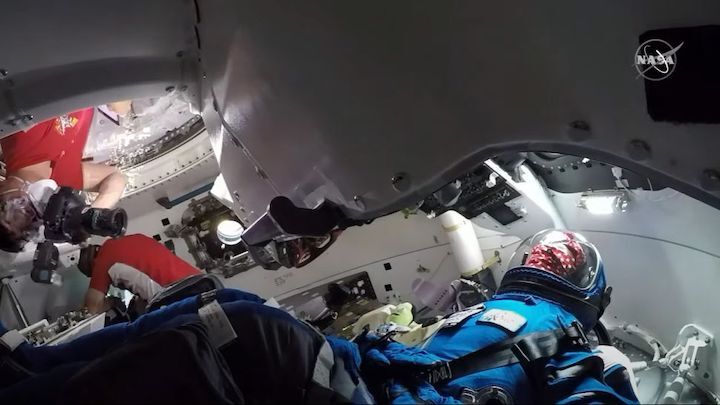 NASA astronaut Kjell Lindgren takes a photo of Rosie the Rocketeer as crewmate Robert Hines works in the background after entering Boeing's Starliner spacecraft for the first time on May 21, 2022. (Image credit: NASA TV)
NASA astronaut Kjell Lindgren takes a photo of Rosie the Rocketeer as crewmate Robert Hines works in the background after entering Boeing's Starliner spacecraft for the first time on May 21, 2022. (Image credit: NASA TV)
Boeing's first Starliner capsule to the International Space Station is officially open for astronauts living on board the orbiting lab.
The commercial Starliner spacecraft, which arrived Friday on an uncrewed test flight to the station, was opened by NASA astronaut Robert Hines at 12:04 p.m. EDT (1604 GMT) to begin about five days of tests on the capsule. It's a major milestone for Boeing and NASA's Commercial Crew Program, which picked Boeing and SpaceX to fly astronauts to the International Space Station in 2014.
"This is the day that they envisioned, where we have three human-rated vehicles docked at the space station right now," Hines said, referring to Starliner, SpaceX'sCrew Dragon and Russia's Soyuz capsule. "So this is a momentous day in NASA's history and just paving the way for the future as we start enabling commercial flight shere in low Earth orbit while NASA visits to the moon and eventually on to Mars."
SpaceX has flown five astronaut flights for NASA since May 2020 but Boeing's Starliner has had a rockier road.
Starliner failed to reach the ISS during the first OFT in December 2019 due tosoftware glitches, and then had its second attempt scrubbed hours before liftoff in August 2021 of after the mission team discovered stuck valves in the capsule's propulsion system. Those problems did not resurface for Starliner's current test flight, called Orbital Flight Test-2 (OFT-2). (Though there have been some minor thruster and cooling system glitches and a slight delay during docking.)
"Those are the kinds of things we expect in flight test and that is why we test," Hines said Saturday. "If we didn't find something like that we're probably doing something wrong." 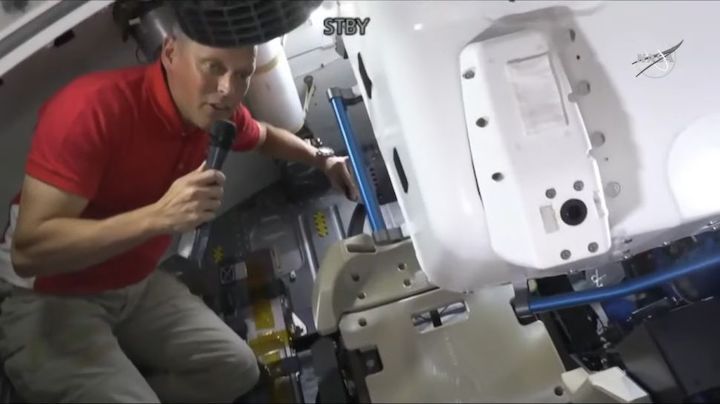 NASA astronaut Robert Hines gives a tour of the Starliner spacecraft. The capsule's pilot's seat can be seen at his lower right. (Image credit: NASA TV)
NASA astronaut Robert Hines gives a tour of the Starliner spacecraft. The capsule's pilot's seat can be seen at his lower right. (Image credit: NASA TV)
The thruster malfunctions shortly after Thursday's launch don't appear to be related to the previous issues the vehicle has experienced. At a post-launch press briefing Thursday night, NASA and Boeing representatives doubled down on their confidence in Starliner to complete its mission, regardless of the new thruster problems.
"The system is designed to be redundant, and it performed like it was supposed to," said Mark Nappi, vice president and program manager for Boeing's commercial crew program.
Starliner spent Thursday night chasing down the orbital laboratory, and it began executing rendezvous test maneuvers just after 3:30 p.m. EDT (1930 GMT) on Friday. Before moving to dock, the capsule successfully demonstrated its ability to stop on command as well as retreat away from the station in case of emergency.
Satisfied with the results, Boeing flight operators instructed Starliner to begin docking procedures, and the vehicle started its slow progression toward the station's Harmony module. At 8:28 p.m. EDT on Friday (0028 GMT on May 21), Starliner officially docked with the International Space Station. Over the next few days, crewmembers aboard the orbiting lab will empty Starliner of 500 pounds (226 kilograms) of supplies and provisions, then pack its hull with nearly 600 pounds (270 kg) of cargo marked for return to Earth.
Staying on board Starliner will be Boeing's test dummy, affectionately dubbed Rosie the Rocketeer, after Rosie the Riveter of World War II-era fame. Clad in one of Boeing's blue spacesuits, Rosie will stay strapped into Starliner's command seat for the ride back to Earth.
Sensors on Rosie were used to measure g-forces experienced on the body during Strainer's first test flight. On OFT-2, the sensors are now being used to measure those same forces' effects on Starliner's seats during reentry and landing. Starliner is scheduled to return to Earth following a four- to five-day stay at the space station, a timeline largely dictated by weather at the vehicle's potential landing sites in the western United States.
Boeing also added an extra bit of fun to Starliner's trip to the space station in the form of a plush toy of Jebediah "Jeb" Kerman, a Kerbonaut from the hit space exploration game Kerbal Space Program, which Boeing used as a zero-g indicator to show when the capsule reached space.
Boeing's 1st Starliner to visit space station looks spectacular in these astronaut photos
The Starliner OFT-2 capsule is stunning in these docking pictures by the station's crew. 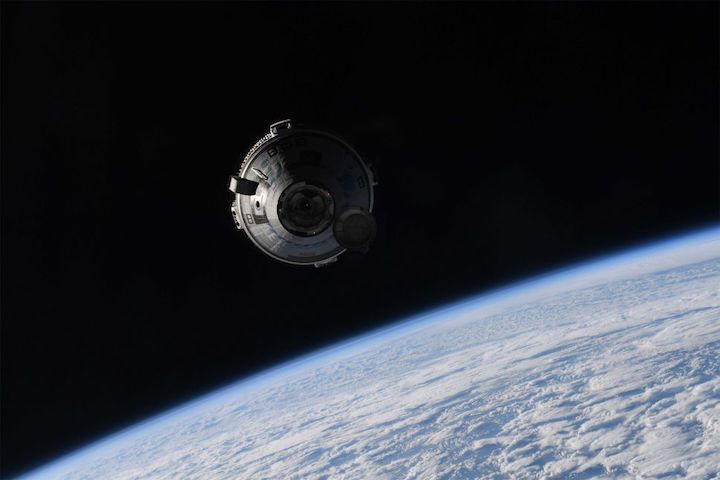 Boeing's Starliner OFT-2 spacecraft approaches the International Space Station in this stunning photo by European Space Agency astronaut Samantha Cristoforetti. (Image credit: Samantha Cristoforetti/European Space Agency)
Boeing's Starliner OFT-2 spacecraft approaches the International Space Station in this stunning photo by European Space Agency astronaut Samantha Cristoforetti. (Image credit: Samantha Cristoforetti/European Space Agency)
It's not every day a brand new spaceship arrives at the International Space Station. So when a Boeing Starliner space capsule made its historic first docking at the orbiting lab this weekend, you can bet astronauts were watching.
Boeing's first uncrewed Starliner spacecraft to visit the station docked Friday night (May 20) and new photos from the orbiting lab's crew captured the moment in spectacular detail. Starliner's mission, called Orbital Flight Test 2, is a critical test flight to see if the commercial space taxi is ready to fly astronauts to the station for NASA.
"Welcome Starliner!" wrote astronaut Samantha Cristoforetti of the European Space Agency, who arrived at the station on a SpaceX Crew Dragon capsule in April. She snapped stunning photos of the Starliner spacecraft over a brilliant blue Earth and shared them on Twitter. 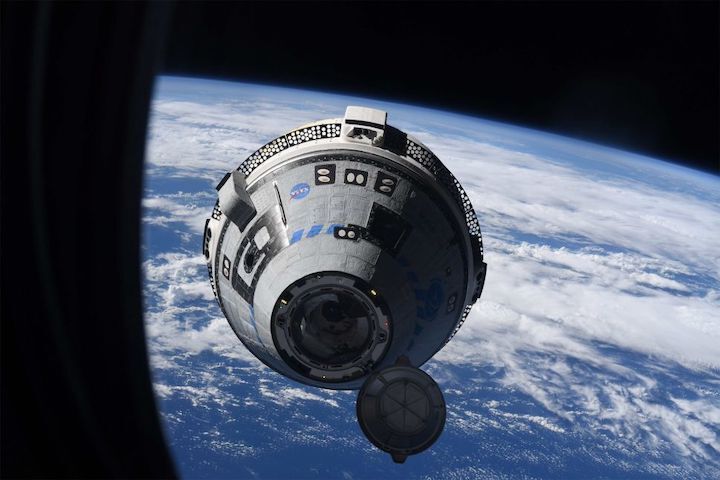



Boeing's Starliner OFT-2 looks like little more than a dot in this view by astronaut Samantha Cristoforetti during docking operations on May 20, 2022. (Image credit: Samantha Cristoforetti/European Space Agency)
In two of Cristoforetti's photos, Boeing's Starliner is seen approaching the International Space Station. Two others show the commercial space capsule after it linked up with a forward docking port on the station's U.S.-built Harmony module.
Still another photo shows Starliner, but just barely. It was taken early in docking operations Friday, when Starliner was a mere light in the vast dark of space.
"She's here!" Cristoforetti wrote at the time. "Only a small dot for now, but soon she will knock at our door."
Cristoforetti snapped her photos of Starliner as two NASA astronauts, Kjell Lindgren and Robert Hines, watched over the spacecraft's approach to make sure it went according to plan.
"Starliner is looking beautiful on the front of the space station," Hines radioed to Mission Control after the docking success.
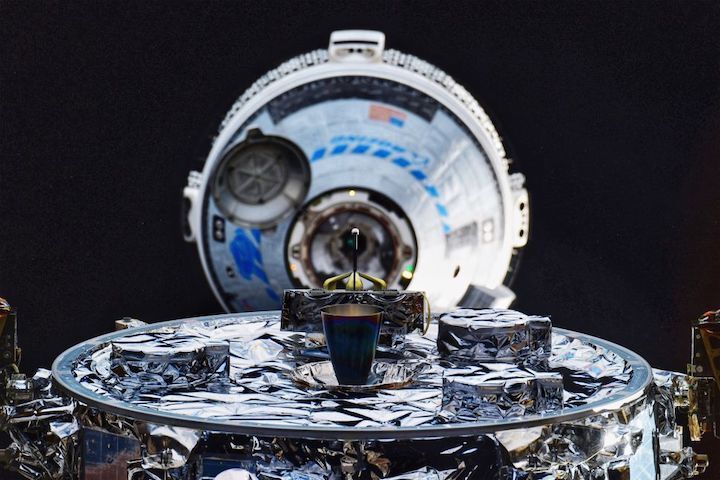
Russian cosmonaut Sergei Korsakov captured these views of Boeing's Starliner OFT-2 capsule as it waited near the International Space Station for docking on May 20, 2022. A Northrop Grumman Cygnus cargo ship is seen at bottom. (Image credit: Sergei Korsakov/Roscosmos)
Still more stunning photos of Starliner were captured by Russian cosmonaut Sergey Korsakov, who snapped images of the approaching Starliner as it was poised behind a visiting Northrop Grumman Cygnus cargo ship.
"Well done, Starliner!" Korsakov wrote on Twitter in one post. Another postshowed Starliner with star streaks behind it.
Boeing's Starliner OFT-2 spacecraft launched into orbit on Thursday (May 19) on an Atlas V rocket that lifted off from Cape Canaveral Space Force Station in Florida. The spacecraft will spend about five days linked to the station while astronauts and Boeing perform a series of tests to measure its performance.
Starliner is one of two commercial spacecraft picked by NASA to fly astronauts to and from the International Space Station. The U.S. space agency picked Boeing's Starliner and SpaceX's Crew Dragon vehicles to fly taxi flights to the station in 2014.
SpaceX has been flying astronauts for NASA since May 2020, but Boeing's Starliner has been delayed by a string of setbacks.
In December 2019, Boeing's first uncrewed Starliner test flight failed to reach the space station when software issues prevented it from reaching its intended orbit. In August 2021, attempts to launch this second test flight were stalled by stuck valves on the Starliner spacecraft.
But on Friday, those problems appeared to be resolved for the most part, though Boeing engineers are investigating some glitches that popped up during Starliner's trip to the station.
Two of 12 main thrusters failed early in the mission and two more smaller reaction control thrusters shut down during Friday's docking operations. Engineers also had to work around a colder-than-expected thermal cooling system loop, but none of the glitches posed a serious risk to the mission, Boeing officials said.
Cristoforetti, Korsakov and the rest of the International Space Station's seven-person Expedition 67 crew will open Starliner's OFT-2 spacecraft for the first time on Saturday. The spacecraft is carrying 500 pounds of supplies and gear for the astronauts.
Boeing currently plans to undock the Starliner capsule on May 25 for a planned land-based landing at White Sands Space Harbor in New Mexico, but that landing target and departure date may chance depending on weather conditions, NASA and Boeing have said.
Quelle: SC
+++
HOUSTON, May 20, 2022 — Boeing’s [NYSE: BA] CST-100 Starliner spacecraft made its first connection to the International Space Station at 7:28 p.m. Central Time (0028 UTC) today to complete a primary goal of the program’s Orbital Flight Test-2 (OFT-2). With no astronauts on board, Starliner’s autonomous systems and ground controllers in Houston guided the vehicle through a carefully choreographed series of maneuvers to steadily bring the Starliner closer to the orbiting laboratory before docking. Astronauts aboard the space station monitored Starliner throughout the flight and at times commanded the spacecraft to verify control capabilities.
“Today’s successful docking of the Starliner is another important step in this rehearsal for sending astronauts into orbit safely and reliably,” said Boeing Defense, Space & Security President and CEO Ted Colbert.
Launching atop a human-rated United Launch Alliance Atlas V rocket on May 19, 2022, from Cape Canaveral Space Force Station in Florida, Starliner spent its first hours in space performing a series of system demonstrations allowing mission managers to verify the spacecraft was healthy and able to maneuver safely. After docking, the Starliner recharged its batteries using solar arrays located on the service module.
After astronauts aboard the station declared “Tally-ho, Starliner,” the vehicle connected to a Boeing-built docking port on the International Space Station.
“Starliner has proven safe, autonomous rendezvous and docking capability,” said Jim Chilton, senior vice president, Boeing Space and Launch. “We’re honored to join the fleet of commercial spacecraft capable of conducting transportation services to the space station for NASA.”
Equipped with a fully functional life support system, as well as all of the other critical systems to support humans, the spacecraft and mission are designed to give Boeing and NASA enough data to certify the spacecraft for long-duration crewed missions to the International Space Station.
During the Starliner’s docked time on orbit, the crew of the station will float inside the spacecraft, conduct an initial cabin tour, and periodically perform system checkouts while ground controllers evaluate data gathered during its flight.
As a leading global aerospace company, Boeing develops, manufactures and services commercial airplanes, defense products and space systems for customers in more than 150 countries. As a top U.S. exporter, the company leverages the talents of a global supplier base to advance economic opportunity, sustainability and community impact. Boeing's diverse team is committed to innovating for the future, leading with sustainability, and cultivating a culture based on the company's core values of safety, quality and integrity. Quelle: Boeing

